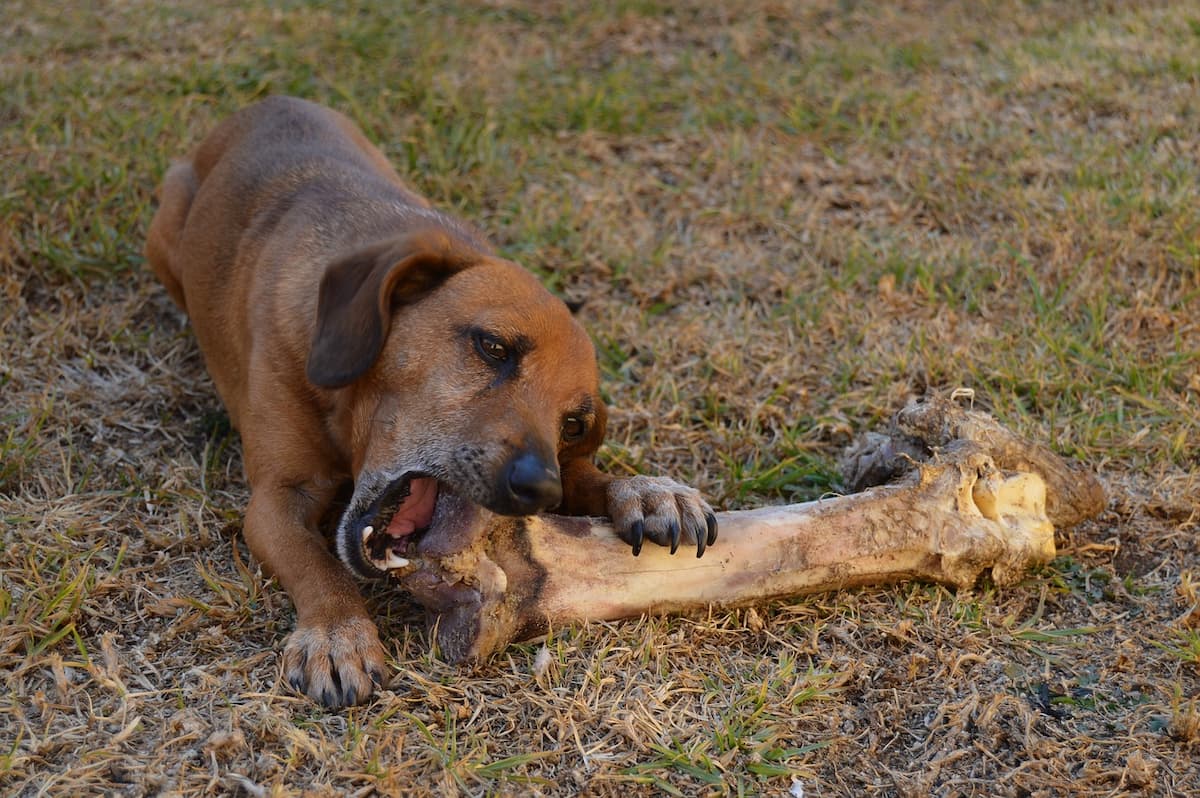Picture this: it’s a lazy Sunday afternoon, and you find yourself lounging on the couch, binge-watching your favorite show.
Out of nowhere, your trusty companion, a furry four-legged friend named Max, softly trots into the room, clutching a bone in his mouth.
His tail wags excitedly as he glances up at you with those pleading eyes, begging for permission to indulge in his newfound treasure.
Now, have you ever wondered why dogs have an insatiable love affair with bone marrow?
Read on to answer the questions: Why do dogs like bone marrow.
Exploring the Reasons Why do Dogs like Bone Marrow?
Dogs and bones have been a classic pairing for centuries.
But have you ever wondered why dogs are particularly drawn to bone marrow?
It turns out, there’s fascinating science behind this canine fascination.
Here are some incredible reasons that explain why dogs just can’t resist bone marrow:
1. Evolutionary Instinct
Dogs, as descendants of wolves, have inherited certain traits from their wild ancestors.
One such instinct is a strong drive to chew on bones.
In the wild, wolves would feed on the remains of their prey, including the nutrient-rich bone marrow.
This primal urge has been passed down through generations of dogs, making them naturally crave the taste and texture of bone marrow.
It’s in their genetic makeup!
2. Nutritional Value
Bone marrow is loaded with essential nutrients that provide a host of health benefits to our four-legged friends.
It’s a rich source of protein, which is crucial for supporting muscle growth and repair.
Additionally, bone marrow contains healthy fats that provide dogs with a steady source of energy.
These fats also aid in the absorption of fat-soluble vitamins, such as vitamins A, D, E, and K, promoting optimal canine health.
But the benefits don’t stop there!
Bone marrow is also a fantastic source of minerals like iron, calcium and phosphorus.
These minerals play a pivotal role in maintaining strong bones and teeth, as well as supporting proper nerve function.
With bone marrow in their diet, dogs can keep their pearly whites in top shape and ensure their bones stay strong and healthy.
Furthermore, bone marrow is a natural source of glucosamine and chondroitin, two compounds that are often found in joint supplements.
These compounds help promote healthy joint function and can aid in reducing inflammation and discomfort in dogs with arthritis or other joint issues.
So, not only is bone marrow delicious, but it can also help keep our furry companions comfortable and mobile as they age.
3. Alluring Aroma
The alluring aroma of bone marrow plays a vital role in attracting dogs.
When you roast a bone with marrow inside, it releases a mouthwatering scent that wafts through the air.
This aroma is packed with compounds that activate a dog’s olfactory receptors and send signals to their brain, igniting their primal instincts.
Dogs have an incredible sense of smell, and bone marrow’s unique fragrance is like a siren’s call that they simply can’t resist.
Not only does the scent of bone marrow captivate dogs, but it also serves as a trigger for their appetite.
The rich, meaty aroma stimulates their taste buds, making them salivate in anticipation.
The enticing smell acts as a Pavlovian stimulus, conditioning dogs to associate it with a rewarding and satisfying eating experience.
It’s no wonder that dogs can’t help but drool when the scent of bone marrow permeates the air!
4. Taste and Texture
Bone marrow is packed with lip-smacking flavors that can send any dog into a tail-wagging frenzy.
Its rich, savory taste appeals to their senses, making it an irresistible treat.
Additionally, the texture of bone marrow offers a satisfying chew that keeps your furry friend blissfully entertained and content.
5. Mental Stimulation
Dogs are smart creatures that require mental stimulation to thrive.
Chewing on bones, especially those with marrow, can provide them with hours of entertainment.
The act of trying to extract the marrow from the bone engages their senses and keeps their minds occupied.
It also serves as a satisfying outlet for their natural chewing instincts, preventing destructive behaviors and promoting dental health by reducing plaque buildup.
Finding Safe and Healthy Bone Marrow Options for Your Furry Friend
Now that we understand why dogs have an affinity for bone marrow, it’s important to focus on finding safe and healthy options for your furry friend.
When selecting bones for your dog, it’s crucial to consider their size, age, and chewing habits.
Opt for raw bones rather than cooked ones, as cooked bones can splinter and cause harm.
Make sure to choose bones that are appropriate for your dog’s size to prevent any choking hazards.
Remember, always supervise your dog while they’re enjoying a bone marrow treat.
If your dog is a vigorous chewer or has a history of dental issues, consider alternatives such as bone broth or stuffed marrow bones.
These options still provide the delectable taste of bone marrow without the potential risks associated with bone splintering.
So, next time you see your furry friend wagging their tail in pure joy while munching on bone marrow, you’ll know it’s not just their taste buds at play, but a primal instinct and a health-boosting habit.
Embrace their love for bone marrow, ensuring you make the right choices to keep them safe and satisfied.
A happy and healthy pup is a bone marrow-loving pup!
FAQ
Q: So, what exactly is bone marrow?
A: Bone marrow is a soft, spongy tissue found in the center of bones.
It plays a vital role in producing new blood cells and immune system components.
In addition to its physiological significance, it also happens to be a flavor-packed treat for our four-legged companions.
Q: Why are dogs so attracted to bone marrow in the first place?
A: Well, dogs have a natural instinct to chew, partially rooted in their ancestral hunting habits.
Back in the wild, their ancestors would devour whole animals, including the bones.
The marrow within those bones became a valuable source of nourishment for them and helped maintain their energy levels.
This instinct has been passed down through generations, causing dogs today to have an innate desire for bone marrow.
Q: Is bone marrow safe for dogs to eat?
A: Generally, yes!
As long as the marrow comes from a raw or uncooked bone, it can be a safe and nutritious treat.
However, it’s crucial to avoid giving cooked bones to your furry friend, as they can splinter and potentially cause harm.
Always remember to supervise your dog while they enjoy their bone marrow to ensure they don’t bite off more than they can chew.
Q: Are there any benefits to dogs consuming bone marrow?
A: Absolutely!
Not only is bone marrow highly palatable for dogs, but it also offers various health benefits.
It is rich in essential nutrients, such as healthy fats, proteins, vitamins (like vitamin A and iron), and minerals (such as calcium and phosphorus).
These nutrients promote healthy skin and coat, aid digestion, boost the immune system, and support overall well-being.
Q: Can too much bone marrow be harmful to dogs?
A: As with any indulgence, moderation is key.
While bone marrow is beneficial in reasonable amounts, excessive consumption could lead to an upset stomach or loose stool.
Moreover, it’s important to consider your dog’s overall diet and calorie intake, as bone marrow should be considered an addition or occasional treat rather than a staple food.
Q: Are there any alternatives to bone marrow for dogs who cannot consume it?
A: Absolutely!
If your dog cannot enjoy bone marrow for any reason, there are several alternatives available.
You can consider other chew treats made specifically for dogs, such as bully sticks, dental chews, or natural rubber toys designed to withstand their chewing instinct.
Consult with your veterinarian to find the best alternatives based on your dog’s specific needs.
Q: What should we keep in mind about bone marrow and dogs?
A: Just remember, bone marrow should always be given in moderation and under supervision.
It’s important to opt for raw or uncooked bones to prevent any potential risks.
Additionally, if you have any concerns or doubts, it’s always wise to consult with your veterinarian for personalized advice based on your dog’s health and dietary needs.
There you have it!
The secret behind why dogs adore bone marrow.
Next time you see your furry friend blissfully enjoying a bone, you’ll know they’re not only savoring a tasty treat but also tapping into their ancestral instincts.
Keep those tails wagging and let them relish the pleasures of bone marrow in a healthy and responsible manner!
The Bottom Line
From the satisfying crunch enjoyed during a bone-chewing session to the rich source of essential minerals and healthy fats that marrow presents, it seems canine cravings for this delectable delight are deeply ingrained in their nature.
beyond the pure pleasure they derive, dogs also tap into their primal instincts when enjoying this delicacy.
Beneath their domesticated exterior lies a lineage that can be traced back to wolves, who depended on bones and marrow as a crucial part of their diet.
So, it’s safe to say that when our canine companions sink their teeth into a bone, they are momentarily reconnecting with their wild ancestry.
But let’s not forget the nutritional value that makes bone marrow such a sought-after treat for dogs.
This hidden treasure is packed with minerals like calcium, phosphorus, and magnesium, which are vital for strong bones and teeth.
Additionally, marrow is a fantastic source of healthy fats, like omega-3 and omega-6 fatty acids, which promote a shiny coat and support overall well-being.
It’s almost like nature has devised a perfect combo – a delicious treat that doubles as a nutrient powerhouse!
So next time you find your furry friend engaged in a bone-chewing frenzy, remember that they aren’t just indulging in a guilty pleasure.
They are instinctively feeding their bodies and souls with a treasure trove of nutrients that have fueled their ancestors for centuries.
While we may not fully comprehend the depths of their passion for bone marrow, we can take solace in knowing that it brings joy and health to our beloved companions.














